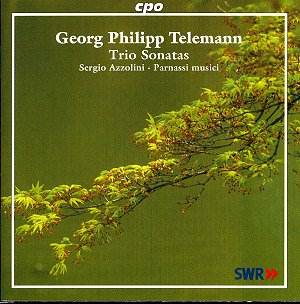Georg Philipp Telemann was one of Germany’s most
productive composers, especially in the field of chamber music.
A large number of collections were published during his lifetime,
in different forms, for all kinds of instruments or combinations
of instruments.
"Like all composers in the 18th century,
Telemann was first and foremost a practical musician who not only
had command of the secrets of the composer’s trade but also knew
how to play all the musical instruments of his day. The intimate
knowledge – and feel for – those musical instruments and their
natural characteristics that this afforded him gave rise to the
joyful air of wholesome, heart-warming music making that radiates
in such generous measure from his music." With those words
of the Czech conductor Milan Munclinger I wholeheartedly agree
having listened to quite a lot of Telemann’s chamber music over
the years.
Often he is portrayed as merely a clever businessman.
He certainly was: he didn’t feel it necessary to promote the publication
of the 6 Trio sonatas recorded here, since he could be sure copies
would circulate in many regions of Germany. And he was right:
both members of court orchestras as well as accomplished amateur
musicians were eager to buy and play these trio sonatas.
But it would be unfair to see him only in this
light. In the preface to his collection ‘Der getreue Music-Meister’
(1728-29) he reveals his intentions when he writes that the function
of music is "to serve one’s neighbour". This reflects
the educational ideal of the 18th century bourgeoisie.
Apart from the quality of Telemann’s works there
is another reason why musicians were eager to know them. As Karl
Böhmer writes in his liner notes, Telemann’s compositions
were "messages from a composer who was accustomed to being
a nose’s length ahead of other composers as far as the spirit
of the times was concerned."
In the ‘VI Trio a Violini e Basso’, published
in the 1720’s, Telemann answers the growing popularity of the
trio sonata form, which had its origins in Italy. A pirate edition,
published in Paris, referred specifically to the Italian style:
"Six sonates en trio dans le goût italien". Within
that framework, however, Telemann’s trio sonatas contain a lot
of variation. All but one of the six sonatas are in four movements.
There are some dance-like elements, some movements have a pastorale
character, sometimes we meet sighing motifs, there is variation
in the amount of imitation between the voices.
The different manuscripts contain contradictory
information as far as the instrumentation is concerned. One requires
2 violins, another 2 transverse flutes, a third violin and transverse
flute. Since the parts never exceed the range and technical possibilities
of the transverse flute, it is safe to say that Telemann wanted
to keep these trio sonatas playable on violins and transverse
flutes alike.
Apart from these six trio sonatas, three other
works are included here. The two sonatas for violin, bassoon and
bc are written in a concerto style. Ritornelli are alternating
with solo passages for violin and bassoon respectively. They are
reminiscent of Vivaldi’s ‘concerti da camera’.
The CD opens with a quartet. It is one of the
‘Six Quatuors ou Trio’ from 1733, which can be performed as a
trio with a ‘basso obbligato’ or as a quartet with ‘basso obbligato’
and basso continuo. Telemann suggests a performance with two bassoons
or two cellos for the two bass parts, with a reinforcement of
the second bass instrument by a harpsichord in the manner of a
basso continuo. The ensemble has chosen for another option: bassoon
as first bass and cello with organ as second bass. It is one of
the liberties the ensemble has allowed itself. Considering the
freedom Telemann used to give the interpreters of his music that
may be justified. More questionable is the performance of the
Trio sonata in A, where in the third movement an organ improvisation
is added which turns the piece into a quartet. Nowhere I can find
the arguments for this decision.
On the other hand, the ensemble did not take
the freedom Telemann seems to have given in regard to the instrumentation.
A performance of some trio sonatas with two transverse flutes
or with the combination violin/flute would have been a nice alternative
to the two violins.
I have listened to this CD with great pleasure.
It is always surprising how much variation Telemann’s music holds.
He may have the reputation to have written music which is easy
to listen to – which is only partly true - but one has to admire
his creativity and imagination. I haven’t been bored one second.
That is also the merit of the performers. They are exploiting
all possibilities of these pieces. Their way of playing is a joy
to listen to: beautiful ornamentation, rallentandi, differentiation
in dynamics and articulation, well-chosen tempi and imaginative
continuo-playing.
Usually, CPO productions are of a high technical
standard. Therefore it is surprising that something has gone wrong
here. According to the track list in the booklet the CD contains
33 tracks. In fact there are only nine: one track for every single
piece, which is very inconvenient. Someone must have taken a nap
at the wrong time ...
Johan van Veen
